YAMAHA XJ600S 2000 Repair Manual
Manufacturer: YAMAHA, Model Year: 2000, Model line: XJ600S, Model: YAMAHA XJ600S 2000Pages: 101, PDF Size: 19.23 MB
Page 61 of 101
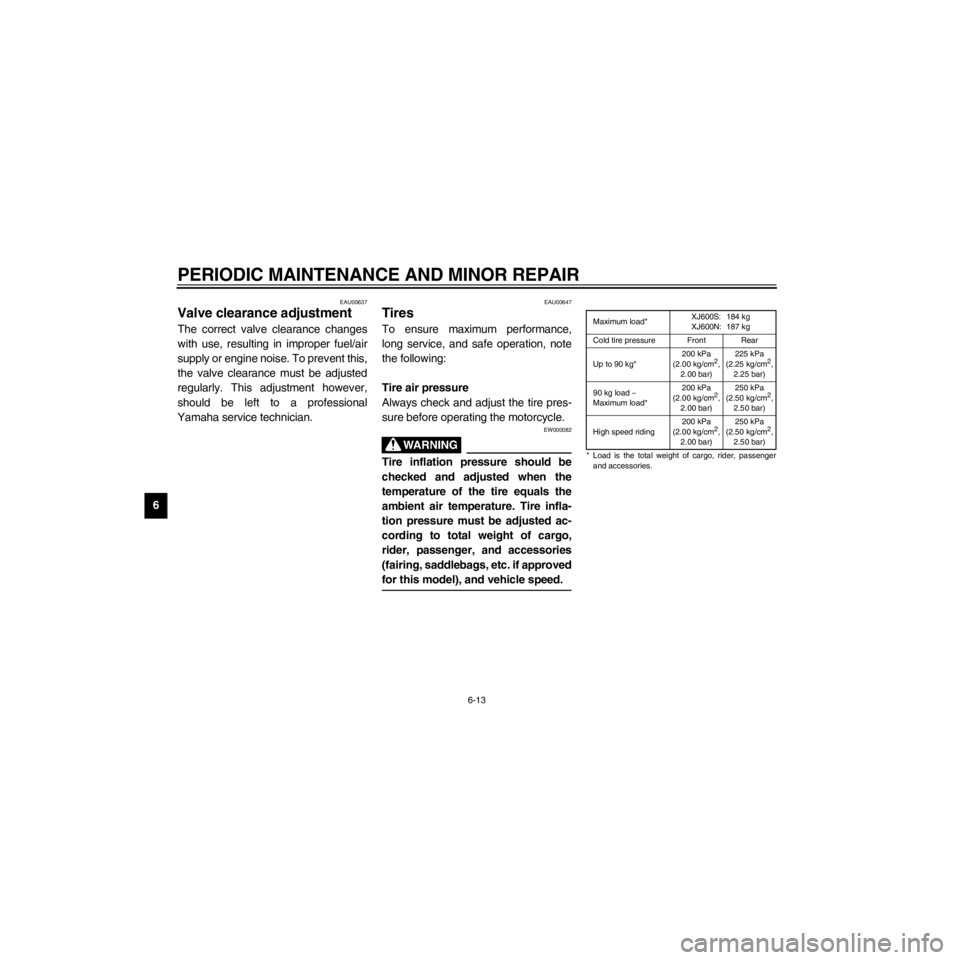
L
6-13
PERIODIC MAINTENANCE AND MINOR REPAIR
/Net/layout8/layout_G2/work/Imai_work/OM-PS/AA9156_XJ600SN-E6/English/E-6.frame
EAU00637
Valve clearance adjustment
The correct valve clearance changes
with use, resulting in improper fuel/air
supply or engine noise. To prevent this,
the valve clearance must be adjusted
regularly. This adjustment however,
should be left to a professional
Yamaha service technician.
EAU00647
Tires
To ensure maximum performance,
long service, and safe operation, note
the following:
Tire air pressure
Always check and adjust the tire pres-
sure before operating the motorcycle.
EW000082
Tire inflation pressure should be
checked and adjusted when the
temperature of the tire equals the
ambient air temperature. Tire infla-
tion pressure must be adjusted ac-
cording to total weight of cargo,
rider, passenger, and accessories
(fairing, saddlebags, etc. if approved
for this model), and vehicle speed.
Maximum load* XJ600S: 184 kg
XJ600N: 187 kg
Cold tire pressure Front Rear
Up to 90 kg*200 kPa
(2.00 kg/cm
2,
2.00 bar)225 kPa
(2.25 kg/cm2,
2.25 bar)
90 kg load ~
Maximum load*200 kPa
(2.00 kg/cm
2,
2.00 bar)250 kPa
(2.50 kg/cm2,
2.50 bar)
High speed riding200 kPa
(2.00 kg/cm
2,
2.00 bar)250 kPa
(2.50 kg/cm2,
2.50 bar)
* Load is the total weight of cargo, rider, passenger
and accessories.
Page 62 of 101
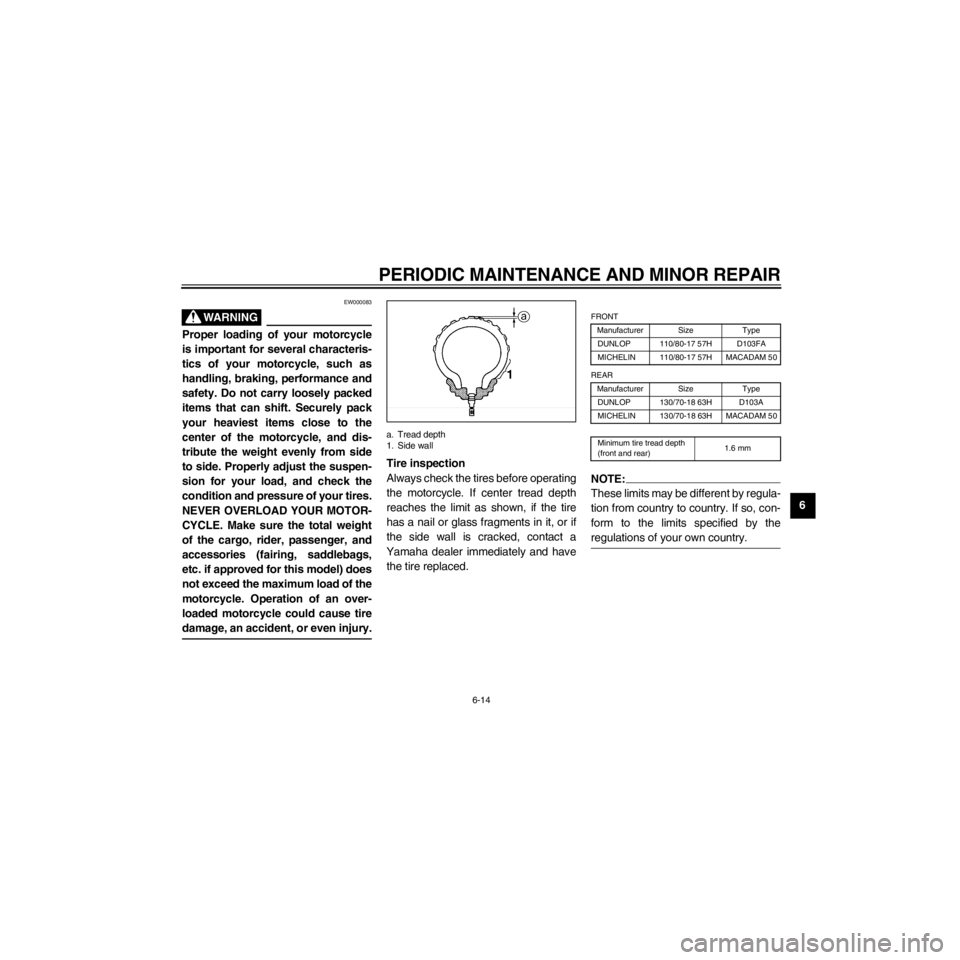
R
6-14
PERIODIC MAINTENANCE AND MINOR REPAIR
/Net/layout8/layout_G2/work/Imai_work/OM-PS/AA9156_XJ600SN-E6/English/E-6.frame
EW000083
Proper loading of your motorcycle
is important for several characteris-
tics of your motorcycle, such as
handling, braking, performance and
safety. Do not carry loosely packed
items that can shift. Securely pack
your heaviest items close to the
center of the motorcycle, and dis-
tribute the weight evenly from side
to side. Properly adjust the suspen-
sion for your load, and check the
condition and pressure of your tires.
NEVER OVERLOAD YOUR MOTOR-
CYCLE. Make sure the total weight
of the cargo, rider, passenger, and
accessories (fairing, saddlebags,
etc. if approved for this model) does
not exceed the maximum load of the
motorcycle. Operation of an over-
loaded motorcycle could cause tire
damage, an accident, or even injury.
a. Tread depth
1. Side wall
Tire inspection
Always check the tires before operating
the motorcycle. If center tread depth
reaches the limit as shown, if the tire
has a nail or glass fragments in it, or if
the side wall is cracked, contact a
Yamaha dealer immediately and have
the tire replaced.
NOTE:
These limits may be different by regula-
tion from country to country. If so, con-
form to the limits specified by the
regulations of your own country.
FRONT
Manufacturer Size Type
DUNLOP 110/80-17 57H D103FA
MICHELIN 110/80-17 57H MACADAM 50
REAR
Manufacturer Size Type
DUNLOP 130/70-18 63H D103A
MICHELIN 130/70-18 63H MACADAM 50
Minimum tire tread depth
(front and rear)1.6 mm
Page 63 of 101
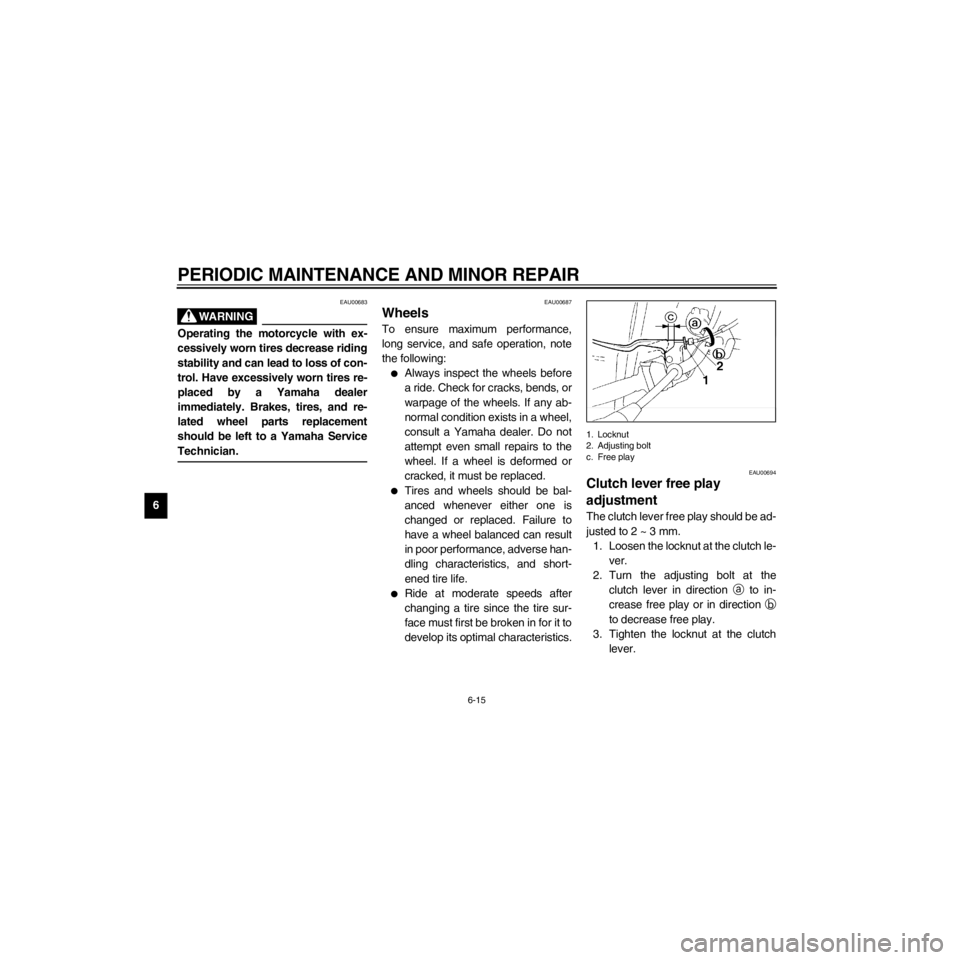
L
6-15
PERIODIC MAINTENANCE AND MINOR REPAIR
/Net/layout8/layout_G2/work/Imai_work/OM-PS/AA9156_XJ600SN-E6/English/E-6.frame
EAU00683
Operating the motorcycle with ex-
cessively worn tires decrease riding
stability and can lead to loss of con-
trol. Have excessively worn tires re-
placed by a Yamaha dealer
immediately. Brakes, tires, and re-
lated wheel parts replacement
should be left to a Yamaha Service
Technician.
EAU00687
Wheels
To ensure maximum performance,
long service, and safe operation, note
the following:
lAlways inspect the wheels before
a ride. Check for cracks, bends, or
warpage of the wheels. If any ab-
normal condition exists in a wheel,
consult a Yamaha dealer. Do not
attempt even small repairs to the
wheel. If a wheel is deformed or
cracked, it must be replaced.
lTires and wheels should be bal-
anced whenever either one is
changed or replaced. Failure to
have a wheel balanced can result
in poor performance, adverse han-
dling characteristics, and short-
ened tire life.
lRide at moderate speeds after
changing a tire since the tire sur-
face must first be broken in for it to
develop its optimal characteristics.
1. Locknut
2. Adjusting bolt
c. Free play
EAU00694
Clutch lever free play
adjustment
The clutch lever free play should be ad-
justed to 2 ~ 3 mm.
1. Loosen the locknut at the clutch le-
ver.
2. Turn the adjusting bolt at the
clutch lever in direction a
to in-
crease free play or in direction b
to decrease free play.
3. Tighten the locknut at the clutch
lever.
Page 64 of 101
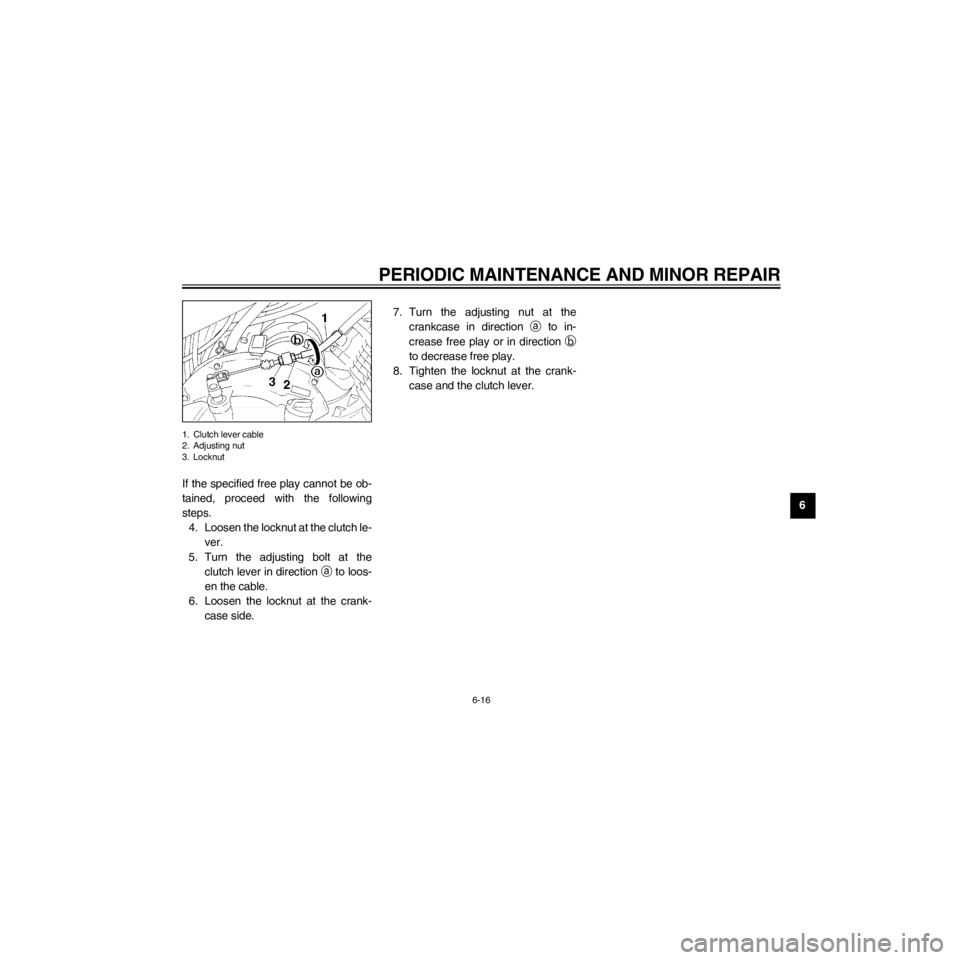
R
6-16
PERIODIC MAINTENANCE AND MINOR REPAIR
/Net/layout8/layout_G2/work/Imai_work/OM-PS/AA9156_XJ600SN-E6/English/E-6.frame
1. Clutch lever cable
2. Adjusting nut
3. Locknut
If the specified free play cannot be ob-
tained, proceed with the following
steps.
4. Loosen the locknut at the clutch le-
ver.
5. Turn the adjusting bolt at the
clutch lever in direction a
to loos-
en the cable.
6. Loosen the locknut at the crank-
case side.7. Turn the adjusting nut at the
crankcase in direction a
to in-
crease free play or in direction b
to decrease free play.
8. Tighten the locknut at the crank-
case and the clutch lever.
Page 65 of 101
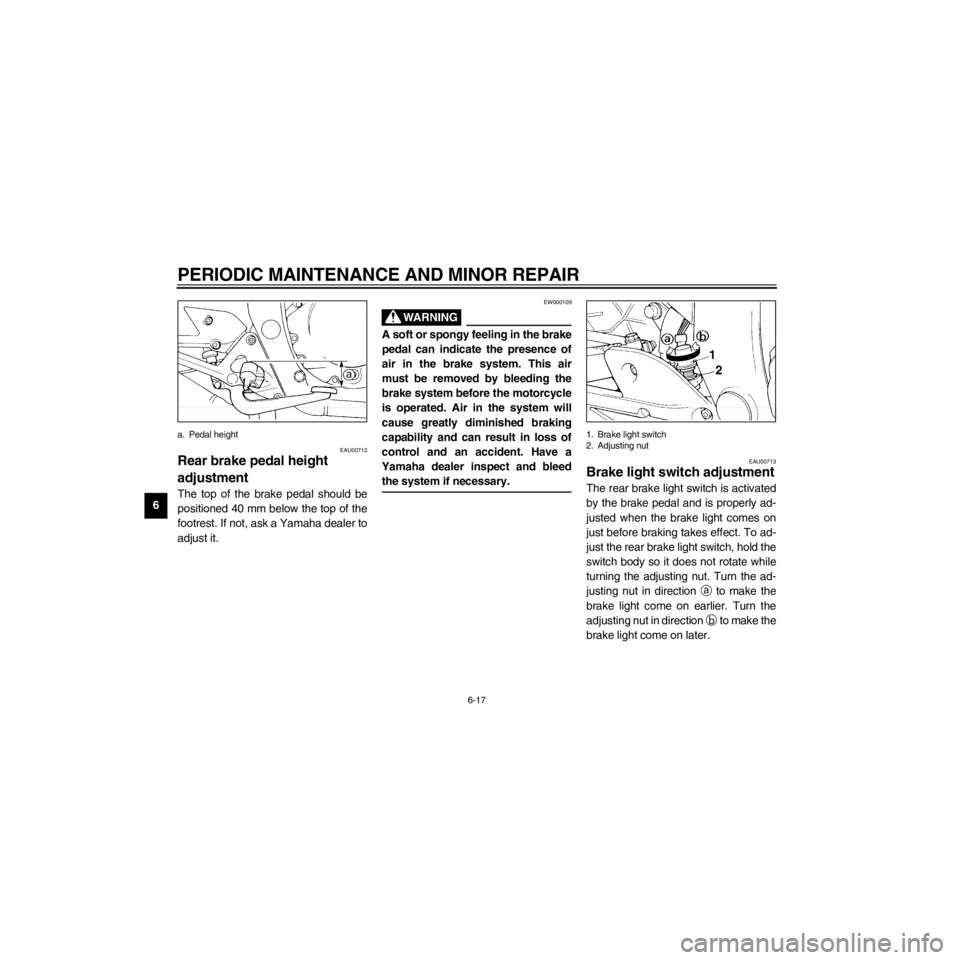
L
6-17
PERIODIC MAINTENANCE AND MINOR REPAIR
/Net/layout8/layout_G2/work/Imai_work/OM-PS/AA9156_XJ600SN-E6/English/E-6.frame
a. Pedal height
EAU00712
Rear brake pedal height
adjustment
The top of the brake pedal should be
positioned 40 mm below the top of the
footrest. If not, ask a Yamaha dealer to
adjust it.
EW000109
A soft or spongy feeling in the brake
pedal can indicate the presence of
air in the brake system. This air
must be removed by bleeding the
brake system before the motorcycle
is operated. Air in the system will
cause greatly diminished braking
capability and can result in loss of
control and an accident. Have a
Yamaha dealer inspect and bleed
the system if necessary.
1. Brake light switch
2. Adjusting nut
EAU00713
Brake light switch adjustment
The rear brake light switch is activated
by the brake pedal and is properly ad-
justed when the brake light comes on
just before braking takes effect. To ad-
just the rear brake light switch, hold the
switch body so it does not rotate while
turning the adjusting nut. Turn the ad-
justing nut in direction a
to make the
brake light come on earlier. Turn the
adjusting nut in direction b
to make the
brake light come on later.
Page 66 of 101
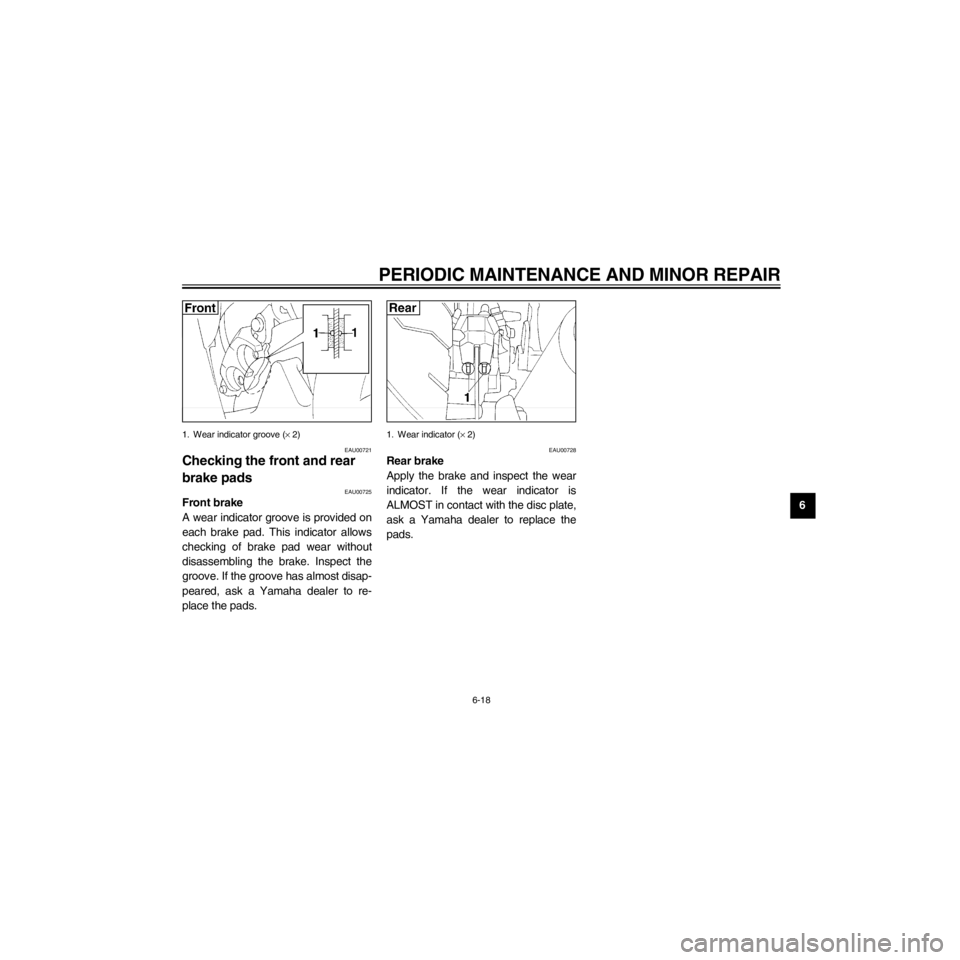
R
6-18
PERIODIC MAINTENANCE AND MINOR REPAIR
/Net/layout8/layout_G2/work/Imai_work/OM-PS/AA9156_XJ600SN-E6/English/E-6.frame
1. Wear indicator groove (´ 2)
EAU00721
Checking the front and rear
brake pads
EAU00725
Front brake
A wear indicator groove is provided on
each brake pad. This indicator allows
checking of brake pad wear without
disassembling the brake. Inspect the
groove. If the groove has almost disap-
peared, ask a Yamaha dealer to re-
place the pads.
1. Wear indicator (´ 2)
EAU00728
Rear brake
Apply the brake and inspect the wear
indicator. If the wear indicator is
ALMOST in contact with the disc plate,
ask a Yamaha dealer to replace the
pads.
Page 67 of 101
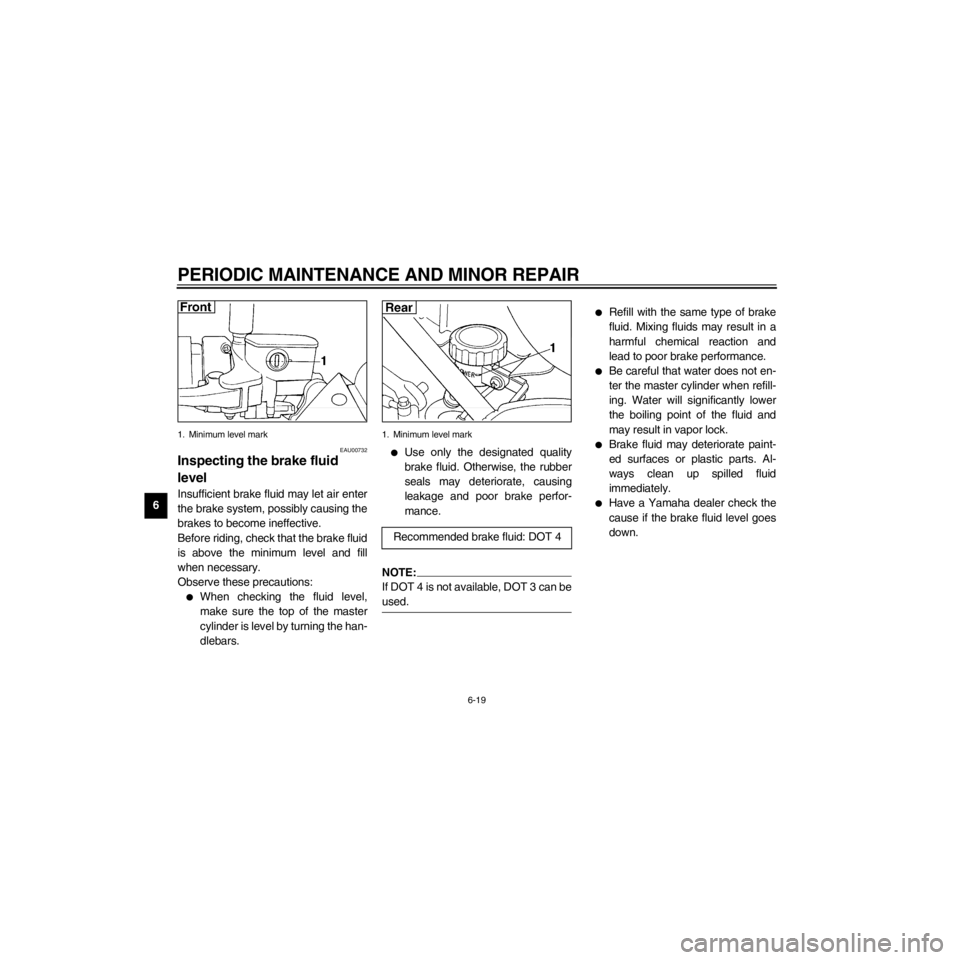
L
6-19
PERIODIC MAINTENANCE AND MINOR REPAIR
/Net/layout8/layout_G2/work/Imai_work/OM-PS/AA9156_XJ600SN-E6/English/E-6.frame
1. Minimum level mark
EAU00732
Inspecting the brake fluid
level
Insufficient brake fluid may let air enter
the brake system, possibly causing the
brakes to become ineffective.
Before riding, check that the brake fluid
is above the minimum level and fill
when necessary.
Observe these precautions:
lWhen checking the fluid level,
make sure the top of the master
cylinder is level by turning the han-
dlebars.
1. Minimum level mark
l
Use only the designated quality
brake fluid. Otherwise, the rubber
seals may deteriorate, causing
leakage and poor brake perfor-
mance.
NOTE:
If DOT 4 is not available, DOT 3 can be
used.Recommended brake fluid: DOT 4
lRefill with the same type of brake
fluid. Mixing fluids may result in a
harmful chemical reaction and
lead to poor brake performance.
lBe careful that water does not en-
ter the master cylinder when refill-
ing. Water will significantly lower
the boiling point of the fluid and
may result in vapor lock.
lBrake fluid may deteriorate paint-
ed surfaces or plastic parts. Al-
ways clean up spilled fluid
immediately.
lHave a Yamaha dealer check the
cause if the brake fluid level goes
down.
Page 68 of 101
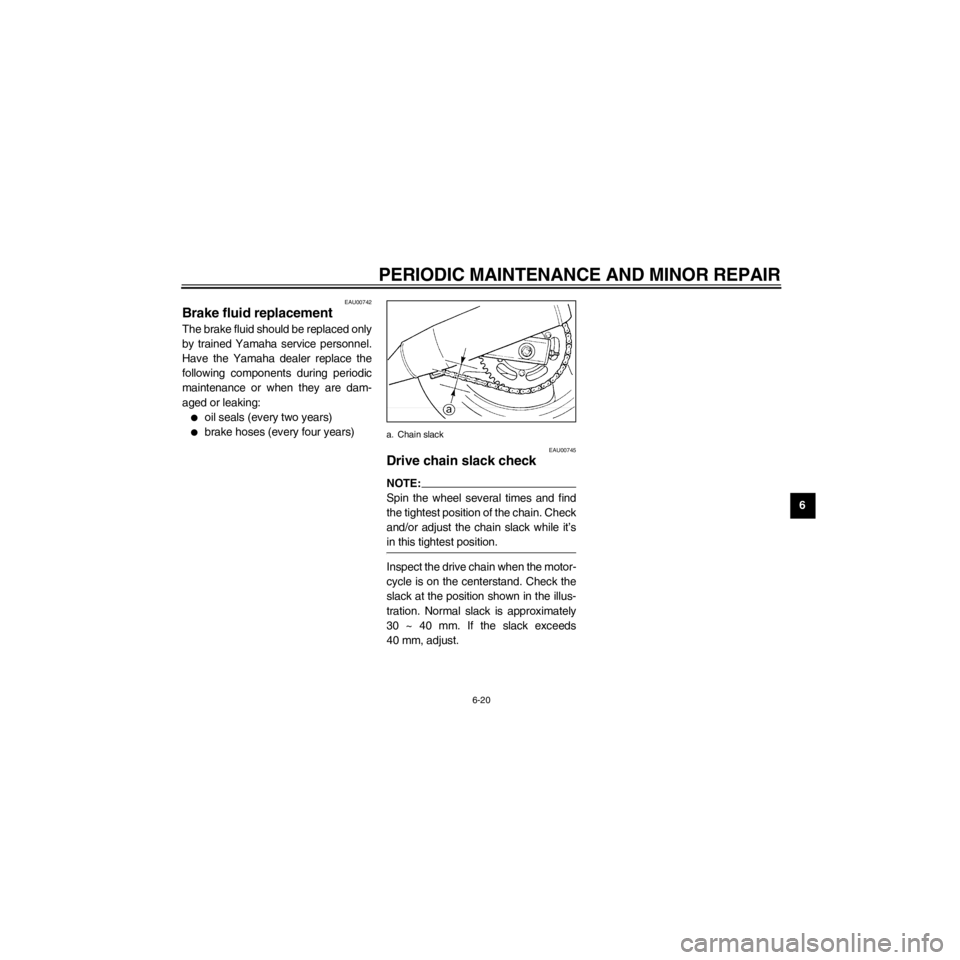
R
6-20
PERIODIC MAINTENANCE AND MINOR REPAIR
/Net/layout8/layout_G2/work/Imai_work/OM-PS/AA9156_XJ600SN-E6/English/E-6.frame
EAU00742
Brake fluid replacement
The brake fluid should be replaced only
by trained Yamaha service personnel.
Have the Yamaha dealer replace the
following components during periodic
maintenance or when they are dam-
aged or leaking:
loil seals (every two years)
lbrake hoses (every four years)a. Chain slack
EAU00745
Drive chain slack check
NOTE:
Spin the wheel several times and find
the tightest position of the chain. Check
and/or adjust the chain slack while itÕs
in this tightest position.
Inspect the drive chain when the motor-
cycle is on the centerstand. Check the
slack at the position shown in the illus-
tration. Normal slack is approximately
30 ~ 40 mm. If the slack exceeds
40 mm, adjust.
Page 69 of 101
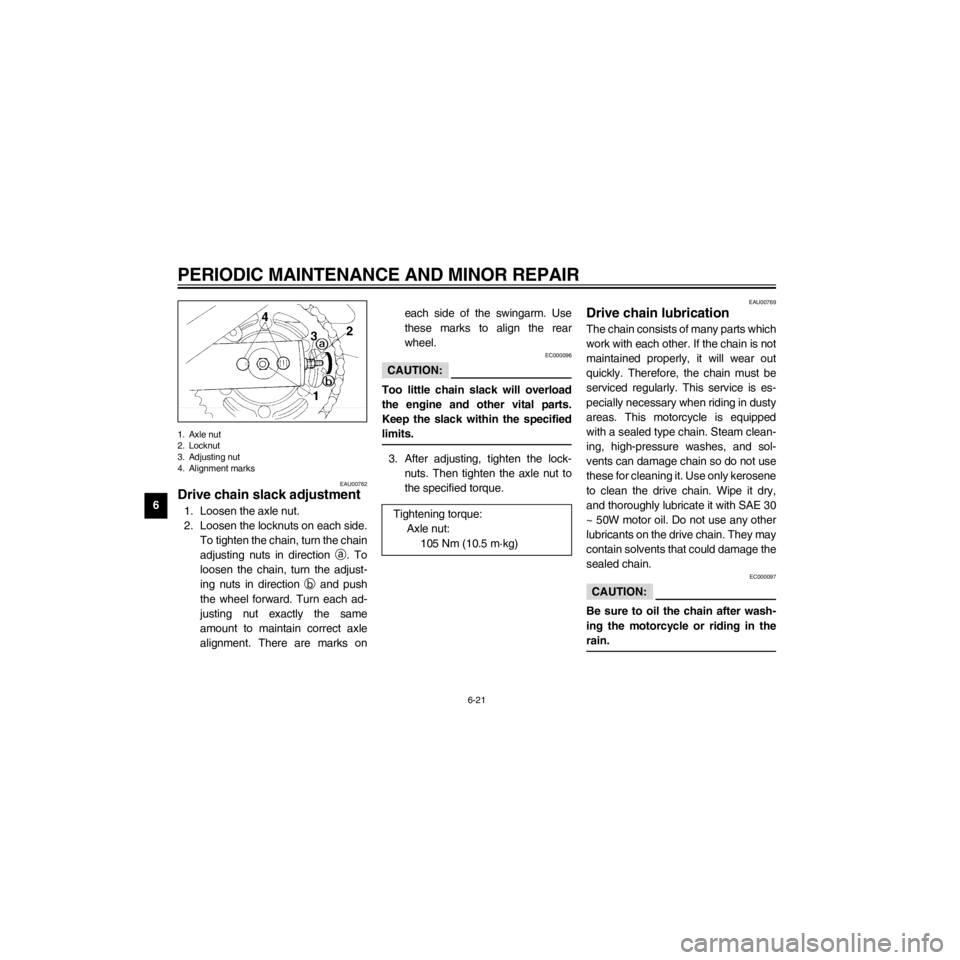
L
6-21
PERIODIC MAINTENANCE AND MINOR REPAIR
/Net/layout8/layout_G2/work/Imai_work/OM-PS/AA9156_XJ600SN-E6/English/E-6.frame
1. Axle nut
2. Locknut
3. Adjusting nut
4. Alignment marks
EAU00762
Drive chain slack adjustment
1. Loosen the axle nut.
2. Loosen the locknuts on each side.
To tighten the chain, turn the chain
adjusting nuts in direction a
. To
loosen the chain, turn the adjust-
ing nuts in direction b
and push
the wheel forward. Turn each ad-
justing nut exactly the same
amount to maintain correct axle
alignment. There are marks oneach side of the swingarm. Use
these marks to align the rear
wheel.
EC000096
CAUTION:
Too little chain slack will overload
the engine and other vital parts.
Keep the slack within the specified
limits.
3. After adjusting, tighten the lock-
nuts. Then tighten the axle nut to
the specified torque.
Tightening torque:
Axle nut:
105 Nm (10.5 mákg)
EAU00769
Drive chain lubrication
The chain consists of many parts which
work with each other. If the chain is not
maintained properly, it will wear out
quickly. Therefore, the chain must be
serviced regularly. This service is es-
pecially necessary when riding in dusty
areas. This motorcycle is equipped
with a sealed type chain. Steam clean-
ing, high-pressure washes, and sol-
vents can damage chain so do not use
these for cleaning it. Use only kerosene
to clean the drive chain. Wipe it dry,
and thoroughly lubricate it with SAE 30
~ 50W motor oil. Do not use any other
lubricants on the drive chain. They may
contain solvents that could damage the
sealed chain.
EC000097
CAUTION:
Be sure to oil the chain after wash-
ing the motorcycle or riding in the
rain.
Page 70 of 101
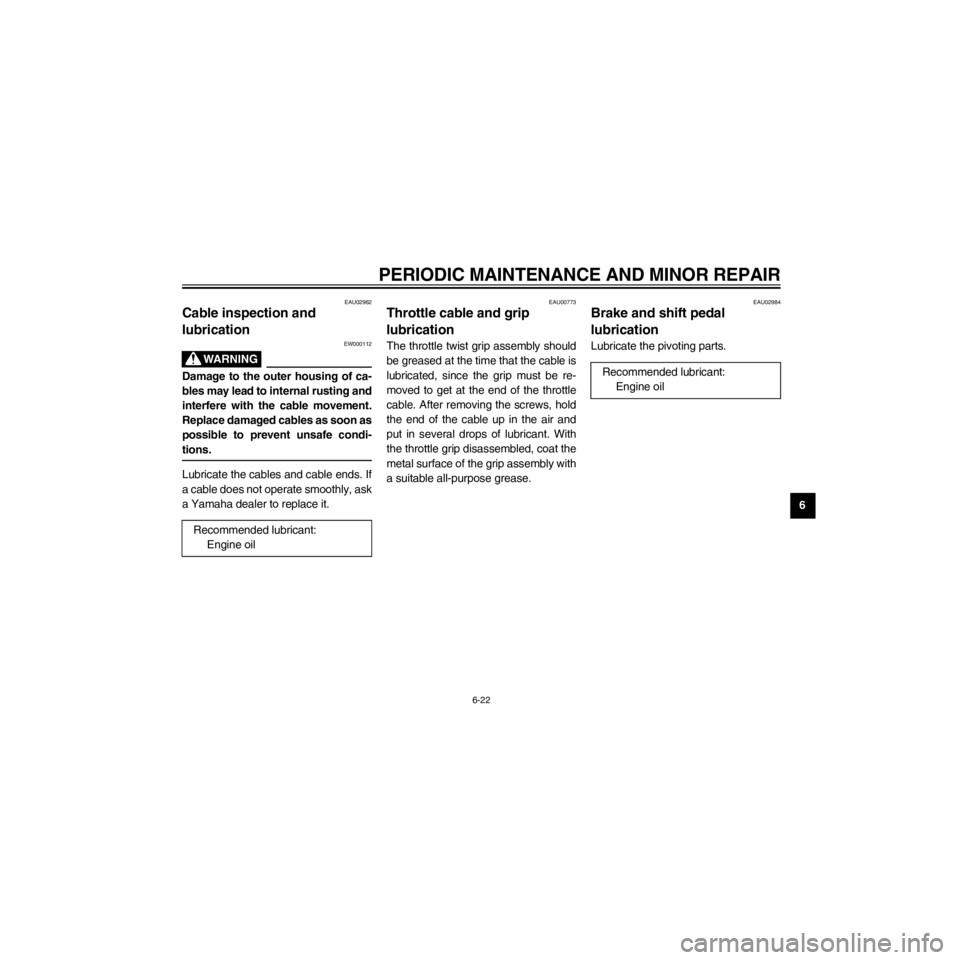
R
6-22
PERIODIC MAINTENANCE AND MINOR REPAIR
/Net/layout8/layout_G2/work/Imai_work/OM-PS/AA9156_XJ600SN-E6/English/E-6.frame
EAU02962
Cable inspection and
lubrication
EW000112
Damage to the outer housing of ca-
bles may lead to internal rusting and
interfere with the cable movement.
Replace damaged cables as soon as
possible to prevent unsafe condi-
tions.
Lubricate the cables and cable ends. If
a cable does not operate smoothly, ask
a Yamaha dealer to replace it.
Recommended lubricant:
Engine oil
EAU00773
Throttle cable and grip
lubrication
The throttle twist grip assembly should
be greased at the time that the cable is
lubricated, since the grip must be re-
moved to get at the end of the throttle
cable. After removing the screws, hold
the end of the cable up in the air and
put in several drops of lubricant. With
the throttle grip disassembled, coat the
metal surface of the grip assembly with
a suitable all-purpose grease.
EAU02984
Brake and shift pedal
lubrication
Lubricate the pivoting parts.
Recommended lubricant:
Engine oil